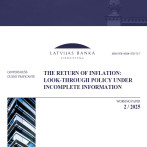Consumer price level down year-on-year
According to the data provided by the Central Statistical Bureau (CSB), the consumer price level in September was lower than a year ago (the annual inflation in September was at -0.5%). The world energy prices continued to bring down inflation. The possible effect of income redistribution and the view of the population that this is no time for saving meanwhile could be among the factors that in several other groups of goods and services continue to sustain demand and price level.
The global oil prices in September were relatively stable and the price of fuel also remained almost unchanged during the month, albeit by 4.8% lower than in August. The world food market meanwhile reacted to the protracted dropping of prices and, in some segments of the market, for example, in the dairy product market, the producers of the main exporter New Zealand protested by reducing their production volumes. According to the Food and Agriculture Organization (FAO) data, the prices of dairy products already went up in September. Latvian retail prices, however, are affected also by more local factors, which resulted in further reductions in the retail prices of these and other food products.
In September, the characteristic seasonal trends in prices were observed, for instance, a drop in fruit and potato prices, rising prices for wearing apparel and footwear as well as education services. In the case of wearing apparel and footwear, the price rises were not as great as usual and became one of the factors that brought down the annual inflation. Yet, under the conditions of low total inflation, a greater than usual rise in book and stationery prices accompanied the increased prices of education services in September (and even already in August). That could serve as one of the examples where the merchant could use the so-called consumption expenditure redistribution effect (i.e., the contracted expenditure for food and energy serves as a motivation to use the rest of the resources for goods and services that at other times would be consumed less). Similarly, the prices of personal care products rose as is the common tendency for the season in September, but the rise was faster than in other years, which could not result from the costs of energy or materials.
Core inflation remained stable in September, including the annual rise in service prices, which remained around 2.5%. A partial explanation could be the aforementioned expenditure redistribution effect. Observing the beginning of the new heating season with even lower heat energy prices and the still relatively advantageous fuel prices (‑18% year-on-year), such an effect could still function in some groups of goods and services in the coming months. It could be short-lived and unstable, however, for the population survey answers (European Commission's consumer sentiment indicators in September) point to a mixed picture. Increasingly fewer among the population consider the time right for saving and that could imply scepticism because of the low interest rates (in such a case, the motivation is to spend now), yet at the same time, increasingly more people think that the overall economic situation is likely to worsen. That, in turn, motivates not to spend (for this reason, savings could be expected to go up). The assessment of the population of price increases has deteriorated, which could be explained by the discussions, topical in September, on the initiatives on raise in indirect taxes, which would increase inflation.
Textual error
«… …»






